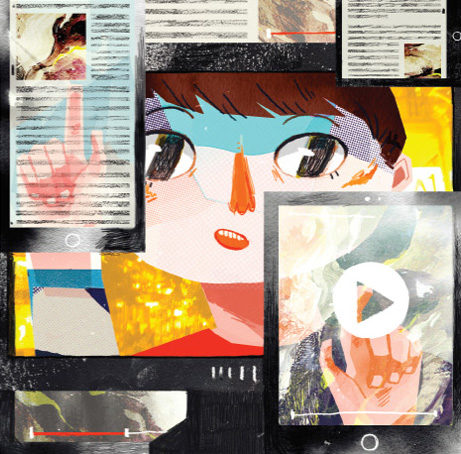Selling the second-screen experience
How CBC’s and Global’s interactive approach keeps stories alive and viewers coming back.
By Harriet Luke
Five medical experts enter the Ideas Room on the third floor of the Canadian Broadcasting Centre in downtown Toronto. They’ve flown in from Saskatchewan, Wisconsin and England to help tackle some complex data. It’s 9 a.m., and the glass-walled room provides a sense of openness as Anita Elash, an associate producer at The Fifth Estate, passes the experts notepads, and five-page booklets containing a few questions to consider. Their mission is to create the first national online rating system for Canadian hospitals. The idea is to give viewers the opportunity to go online and rate their hospitals in five categories: respect, communication, timeliness, cleanliness and whether or not they would recommend them.
There’s a quick demonstration of a similar Irish website, then the conversation flourishes between the experts and the CBC team. They discuss the availability and limitations of medical data. After 5 p.m., the meeting comes to a close, but the discussion doesn’t end there, as Elash will continue to relay emails and phone the experts with questions.
Rate My Hospital required one of the largest teams Jim Williamson, executive producer of The Fifth Estate, has ever assembled. Within 24 hours of the website’s premiere in April 2013, the online rating system had over 23,000 responses and plenty of comments—some positive, some negative. Along with the rating tool, CBC assigned letter grades to 239 facilities across the country. This was the part of Rate My Hospital designed to ignite conversation about the state of Canadian healthcare. Indeed, the grading system sparked the most controversy; the hospital report card was the bait that hooked Canadians and reeled them in to the website.
Creating new experiences that differ from passive TV watching keeps viewers interested and entertained—and news organizations relevant. Multiplatform stories are a matter of survival for broadcasters, says Williamson. But they’re also an opportunity: data-led investigative projects engage audiences and offer a chance to stand out in a noisy online world. Since stories can live longer outside the television set, producers are turning to interactive features and online experiences to capture and keep a loyal audience.
***
With the average Canadian spending 45 hours per month online, broadcasters face the challenge of keeping their audience’s attention. One way they can do this is by taking advantage of the fact that 50 percent of Canadians have a smartphone or tablet with them while watching television, and offering a “second screen” experience that lets viewers interact with a show via social media or a website. Broadcasters can also create interactive and multiplatform stories that offer audiences a way to consume information before or after the show. Interactive features encourage viewers to take part in the story, allowing them to leave the passenger’s seat and put both hands on the steering wheel.
As television audiences move online, the ability to connect with viewers means greater engagement and a larger community for the broadcaster. “The vast majority of creators, producers and broadcasters now embrace the fact that you cannot tell a story in a screen-based industry without reaching out on all platforms,” says Catalina Briceno, director of industry and market trends for the Canada Media Fund. The CMF is a public-private partnership created in 2010 by the Department of Canadian Heritage to fund and promote productions.
Over the past few years, the CMF has seen a steady increase in the number of applications from digital media. According to the organization, “funding to English documentary digital media components has grown . . . from $0.7 million in 2011–2012 to $5.5 million in 2012–2013.” Its 2013–14 budget is $360.7 million.
Rate My Hospital is one example of a multiplatform project. CBC aired the documentary segment two days after launching the online rating system. Throughout the show, host Bob McKeown reminded viewers to check the site and rate their hospitals, then see how the broadcaster graded each facility. This allowed the show to live past its air date, drawing viewers back to the website to see how other Canadians rated various hospitals.
What was different about this project was that the website acted as the first screen. Williamson says getting important information about hospitals out there was the priority. “For months I resisted assigning people to do the television show,” he says, noting that he wanted it to be largely an online story. Marissa Nelson, senior director of digital media for CBC news and Centres, wants her staff to continue to challenge the standard storytelling format. “I don’t think there’s enough of that in Canada,” she says. From a business perspective, this type of tool is about creating loyal viewers and an audience that will want to tune in week after week—and about getting people to stay on the site longer. “Maybe they stay 10 minutes instead of two,” says Nelson. “And they’re more likely to remember CBC news than any other competitor.”
***
Anna Mehler Paperny, senior producer of data desk investigations at Global News, works two desktop computer monitors, scrupulously analyzing Excel spreadsheets. What looks like the equivalent of an unfinished Rubik’s Cube is, to Paperny, a collection of patterns to be discovered and puzzles to be solved.
Senior web co-ordinators Patrick Cain and Leslie Young sit across from her. Cain is soft-spoken, but his hands animate as he talks about analyzing the data he deals with. He can tolerate repetitive work, but admits that when handling multiple spreadsheets, “It can be really easy to screw up.”
A bigger problem, though, is gaining access to data from governments and private companies. “When those bastards make it hard for me to get something, it motivates me even more,” says Cain, adding that the information he usually wants comes in PDF files—making it difficult to transfer the data into an Excel document so he can analyze it. But the team saves time by using software and templates from previous pieces.
The results are often worth the headaches. Young’s series The Gardiner: Trouble Overhead won the 2012 Radio Television Digital News Association awards for best in-depth and investigative series and best digital media series. For that look at Toronto’s slowly crumbling Gardiner Expressway, she created an interactive map that showed where concrete was falling. Along with the map, Global wrote a series of articles with embedded links via DocumentCloud to show that the city “downplayed Gardiner structural concerns.”
The data desk posts as much of the original data as it can. “People want to know where this information comes from,” says Paperny. David Weisz, a freelance digital journalist who has done work for Global, says, “You can run a print story with unnamed sources, but you just can’t do that for data.”
Created in 2010 to produce original pieces for the web and provide additional context for news stories, the data team originally worked at Global’s satellite office in downtown Toronto, but now sits in the centre of the main newsroom in the suburbs. The move came after executives realized just how important the team’s work is. “If we want to distinguish ourselves from other news organizations,” says Ron Waksman, a senior online director at Global News, “it is not enough to take what we do on the broadcast side and push it across to online.”
He says there’s a gold mine of undiscovered information that has sat untouched and he wants his team to dig into it. “Oxycontin’s gone, but Canada’s pill-popping problem is worse than ever” went up on Global’s website in March 2013 with graphs and charts that viewers could click for more information. This led the team to the November 2013 data-led story that showed deaths from opioid use had declined while those from other painkiller prescriptions had drastically increased. “Data can change from year to year,” says Paperny. “This means you can continue a story a month or a year later and people will still be interested.”
***
Armed with leaked financial documents that exposed offshore tax havens, CBC’s Special Investigations Unit decided to produce an interactive to make the complicated information accessible to everyone. But during the first couple of meetings for Stashing Their Cash, the journalists and tech team were speaking different languages. “I had no idea what was going on,” says Harvey Cashore, senior producer of the unit, and it took a few meetings for the two groups to understand each other as they brainstormed ideas. “We realized that my idea was far too complex and would have taken probably two years to build.”
This is not unusual. “A lot of the time I’m trying to get the person making the TV show to let go of their preconceived notions,” says Sean Embury, principal and creative director at Fulscrn, a company that helps networks with creative development and accessing funds. He believes this type of storytelling provides another level of comprehension that television can’t always provide, but broadcasters often underestimate how long it takes to produce a complex interactive story. Even the research for these ambitious investigative stories can take a lot of time; Rate My Hospital, for example, took about nine months to create.
Multi-screen experiences can be costly and can require hiring experts, as Rate My Hospital and Stashing Their Cash did. Fortunately, a lot of material and research that goes into a television show can also be used for its accompanying online interactive piece. Embury cites Truth and Lies: The Last Days of Osama bin Laden as an example of how CBC maximized its content. Interviews gathered for The Fifth Estate episode were incorporated into the online story. “I don’t want to spend twice as much telling my story five different ways or on five different platforms,” says Embury, “so a lot of it has to do with planning.”
Williamson’s team now has weekly meetings to discuss how best to communicate stories and on what platform. CBC won’t be able to do big projects all the time—Nelson says the network will focus on one or two a year and try to knock them out of the park—but the numbers make them attractive. Rate My Hospital has drawn more than two million page views and nearly 64,000 ratings on the patient rating tool. During the 2011 federal election, the Vote Compass tool, which asks users a series of questions and matches them with the most appropriate party platform, had almost two million respondents. And Stashing Their Cash, one of CBC’s most successful interactive stories, was shared on websites such as NYTimes.com.
***
Alex Bottle, an associate professor of medical statistics, arrived from London the night before the Rate My Hospital expert panel meeting. CBC wanted his advice on measuring and presenting the information gathered to rate the hospitals. Bottle spent weeks researching the Canadian healthcare system to prepare. While eager to be a part of the project, and knowing that CBC wanted to get it right, his initial concern was that this was being done for the first time in Canada—and by journalists.
Gary Teare, director of Quality Measure and Analysis with Health Quality Council Saskatchewan, was worried the journalists didn’t truly understand the limitations of the data they were looking at. “I’ve been doing this for years,” he says, “so I’m aware of how difficult it is.”
The holes in the data were not CBC’s fault; individual hospitals record information such as infection rates differently, and some hospitals aren’t required to report much at all. Elash was surprised by how little information is available to the public, and by the secrecy surrounding hospital data. Teare says CBC did the best it could with the information it had, but the “fundamental weakness in the analysis is the reliability of the underlying data to begin with.”
Because of this, some of the experts worried about the plan to rank the hospitals A through D. “I was less thrilled about the grading system,” says Teare, who attempted to put together an Ontario hospital report card 10 years ago. Back then, he and other medical experts had the same questions as CBC but didn’t create a “multiple-level grading system because the data wouldn’t support it.”
Elash says the report card was a way to start a conversation, and it did a good job of that. But some experts thought it was a way to get attention with controversial content. Sholom Glouberman, president of Patients Canada, says, “I thought the project was very dangerous. . . . What it did was it eroded people’s confidence in the healthcare system unnecessarily.”
He believes it also reinforced the notion that healthcare issues are the fault of individual hospitals and acute care, when the public should be focusing on chronic conditions and how well our system manages them. Yet it did start a conversation between the public and healthcare providers, and got people thinking about the way Canada’s system works.
Vote Compass also generated discussion. Heather O’Brien, a professor at the School of Library, Archival and Information Studies at the university of British Columbia, used Vote Compass during the last B.C. election and says finding out which political party the tool assigns you became a hot topic among her colleagues. “It was sort of a game around the lunch table,” says O’Brien. “‘So what did you turn out to be?’”
Part of her research looks at what motivates people to use a particular website. When it comes to news sites, visitors value the various aspects of multiplatform stories differently. “For some people, the value added is the content, and other people really think about the value in the interactive components,” she says. “It’s a really complex puzzle of different users with different motivations.”
Some users had a problem with Vote Compass’s content. Brian Kelcey, a Toronto public policy consultant and former Conservative aide, argues the tool assigns values for voters based on their opinion of a party rather than on the party’s actual accomplishments; it shows platforms but doesn’t provide any links to past performance. “The CBC has access to this information,” he says. The interactive also doesn’t account for changes in policy during campaigns, which can cover decisive issues. Kelcey believes the tool is put up in a rush come election time, adding, “There’s such a race to get the Vote Compass engine out to draw clicks and users and page views into the CBC website and get everyone hooked on their election coverage.”
***
Technology lets producers link to more information and add more depth to the stories they tell, but interactive, data-led investigations are also changing the editorial direction. “The force used to be from broadcast to online,” says Waksman. But that isn’t what viewers want now; they want original reporting. “The future is not about commodity news, what happened today,” he says. It’s about going deeper into stories, investigating and providing analysis and context.
News organizations realize that smartphones, tablets and laptops aren’t necessarily second screens anymore. Waksman sees Global as a network, not a broadcaster, and it needs to provide its audience with a variety of ways to consume and interact with news. “You apply the medium that makes the most sense.”
Waksman plans to add to his data desk team and Elash plans to keep Rate My Hospital going. “It was a call to hospitals to be accountable, to be open, and I think you can’t call for that and go away,” Elash says. “You have to stay on the story.”
The former freelance health reporter and Toronto Sun staffer is working on meeting with her experts again. CBC will launch a new version of Rate My Hospital in the fall, and this time, the team will have a better sense of the challenges, says Elash. “We didn’t fully understand what we were up against.”
by Harriet Luke
Harriet Luke was the Multimedia Editor for the Spring 2014 issue of Ryerson Review of Journalism.














































